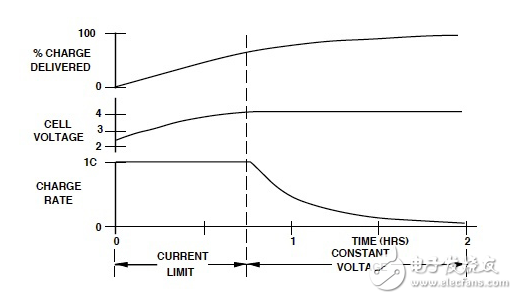
资料下载

恒压恒流装置优化锂离子电池充电
恒压/恒流装置优化锂离子电池充电
锂离子电池作为一种常用的储能装置在许多能源收集应用中应运而生。对于工程师来说,最大限度地提高电池的性能和生命周期,需要使用电池充电电路,能够考虑到李离子电池的特殊特性。工程师可以成本有效地建立锂离子从制造商包括模拟设备,半导体公司,飞兆半导体、富士通半导体,Intersil,线性技术,集成电路芯片技术,Micrel,计费功能,德克萨斯文书。
与其他许多电池技术不同,李离子电池需要在一个紧密的信封内保持充电配置文件。一个少收的锂离子电池无法提供其额定输出能量。另一方面,充电电路不能将李离子电池电压超过推荐的限制,也不能应用超过制造商推荐水平的充电电流。无论哪种情况,过电压或过充电电流的应用开始破坏李离子电池,从而降低电池的整体寿命,甚至造成灾难性的故障。对于工程师来说,最大的挑战是充电速度和电池电压不至细胞。

To achieve this balance, Li-ion charging typically follows a two-phase approach (Figure 1)。 In the first phase, typically called the constant-current, or current-limit, phase, the cell is charged at the maximum charging rate recommended by the battery manufacturer. This rate, typically called the 1C rate or fast-charging rate, is a charging current equal to the ampere-hour rating of the cell. When the cell reaches a specified set-point voltage, typically 4.2 V, cell capacity has reached only 65 percent to 70 percent of its maximum value but further fast-charging rates risk damaging the cells. As a result, charging circuits switch to the second phase, or constant-voltage phase. Here, the charging circuit will provide only enough current to maintain the voltage of the battery constant at this set-point voltage. As a result, the charging circuitry will continually reduce the charging current over time, resulting in a gradual decay of the charging current profile as shown in Figure 1.
声明:本文内容及配图由入驻作者撰写或者入驻合作网站授权转载。文章观点仅代表作者本人,不代表电子发烧友网立场。文章及其配图仅供工程师学习之用,如有内容侵权或者其他违规问题,请联系本站处理。 举报投诉
- 相关下载
- 相关文章




